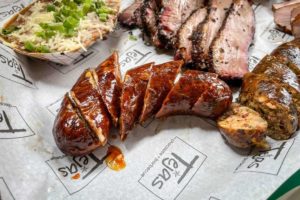 One reason why barbecue is such a tough business is because the process of smoking meat can be wildly uneconomical.
One reason why barbecue is such a tough business is because the process of smoking meat can be wildly uneconomical.
Take brisket, for example. A pitmaster receives a raw brisket that weighs 14 pounds. The brisket first needs to be trimmed of any extra fat and rough edges to ensure it cooks properly in the smoker. This results in about two pounds of fat being removed.
After the brisket cooks for 12 or so hours, another five pounds of fat and moisture renders out of the brisket. The weight of the cooked brisket is now seven pounds.
So the pitmaster pays for 14 pounds of brisket and ends up with seven pounds he can sell after it is cooked. Thus, only about 50% of the raw product can be turned into revenue-generating smoked meat. This number is the “yield.”
In the barbecue business, yields are low (50% and under). This can be compared to a steakhouse where a typical 16-ounce ribeye might weigh 12 ounces after cooking, resulting in a 75% yield. Not bad.
In the past, losing 50% of your raw product in the cooking process might not matter when brisket cost $1-$2 per pound. Those two pounds of brisket trim often just ended up in the trash. I remember cooking recipes at home that called for beef fat and just going to my local H-E-B and asking the butcher for a bag of trim fat and they’d give it away for free.
Not anymore. As the wholesale cost of brisket approaches $4 per pound, that pile of trimmed brisket fat is almost the equivalent of $8 being thrown in the trash. And many barbecue joints trim 40 briskets a day. That’s $320 a day, $2,240 a week, and a staggering $8,960 a month potentially going into the bin.
So how can a pitmaster turn all or part of that brisket trim (mostly fat) into a revenue-generating product?
In cooking, fat is used for two main purposes: adding flavor and moisture. In the barbecue business, one application for efficiently using brisket trim is adding flavor and moisture to sausage.
You may have noticed many barbecue joints now offer “housemade sausage.” You might think this is due to the pitmaster becoming ambitious and wanting to produce a unique sausage to help them stand out from the pack. And that may be the case. But it is also due to the current economics of barbecue, specifically the requirement to efficiently use all raw products, which now makes it a necessity to take on the physical and time-consuming process to produce handmade sausage.
Problem solved, right? Not quite. Most sausage recipes call for about 20% fat in the mixture along with ground meat and spices. So, if a barbecue joint produces 80 pounds (2 pounds of trim per brisket times 40 briskets) of usable brisket trim per day, they’d need to make and sell 400 pounds of sausage a day to incorporate all that trim. That’s a lot of sausage!
Indeed, most restaurants can’t sell that much sausage per day. So what to do with all the extra sausage produced with all that extra brisket trim?
Again, pitmasters are getting creative. Now you see many barbecue joints offering fully-cooked sausage that has been vacuum-sealed, refrigerated and sold via mail-order or take-away that can be reheated at home. In effect, they’re selling their version of the packaged sausage you find at any grocery store. Tejas Chocolate & BBQ in Tomball has become well-known for their reheatable, packaged meat items.
By expanding the market for their sausage, barbecue joints can now more efficiently re-purpose brisket trim and offer unique products both in their restaurant as well as to consumers all over the country via mail order. As beef prices rise, economic necessity really is the mother of invention at Texas barbecue joints.




0 Comments